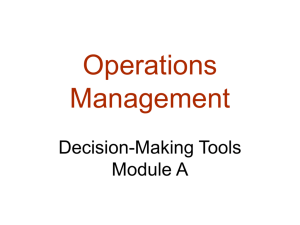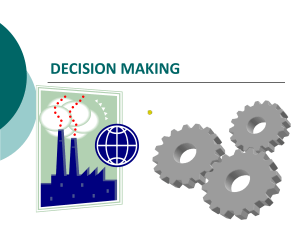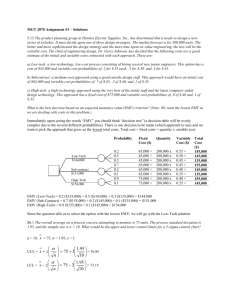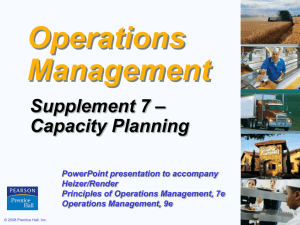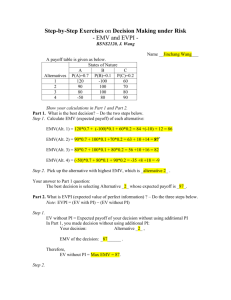if you would like to the original PowerPoint file
advertisement
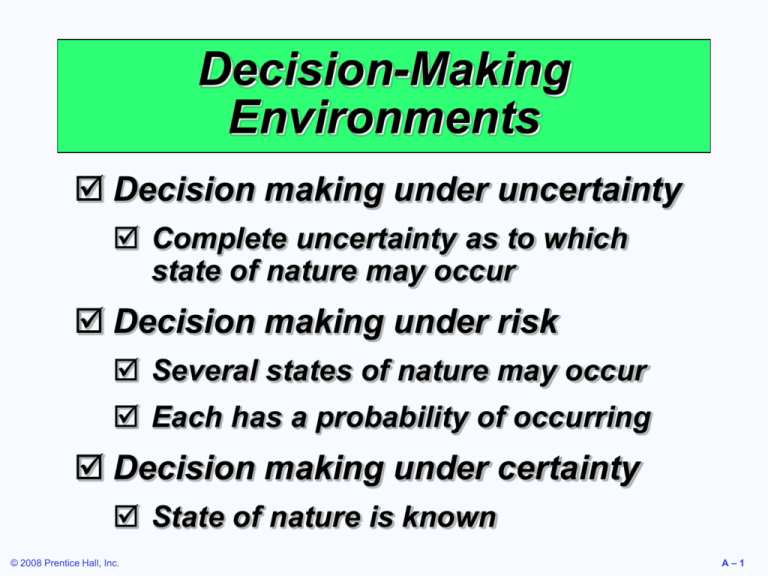
Decision-Making Environments Decision making under uncertainty Complete uncertainty as to which state of nature may occur Decision making under risk Several states of nature may occur Each has a probability of occurring Decision making under certainty State of nature is known © 2008 Prentice Hall, Inc. A–1 Uncertainty 1. Maximax Find the alternative that maximizes the maximum outcome for every alternative Pick the outcome with the maximum number Highest possible gain This is viewed as an optimistic approach © 2008 Prentice Hall, Inc. A–2 Uncertainty 2. Maximin Find the alternative that maximizes the minimum outcome for every alternative Pick the outcome with the minimum number Least possible loss This is viewed as a pessimistic approach © 2008 Prentice Hall, Inc. A–3 Uncertainty 3. Equally likely Find the alternative with the highest average outcome Pick the outcome with the maximum number Assumes each state of nature is equally likely to occur © 2008 Prentice Hall, Inc. A–4 Decision Table Example Alternatives Construct large plant Construct small plant Do nothing State of Nature Favorable Market Unfavorable Market £200,000 –£180,000 £100,000 –£ 20,000 £ 0 £ 0 Table A.1 © 2008 Prentice Hall, Inc. A–5 Uncertainty Example States of Nature Alternatives Favorable Market Unfavorable Market Construct large plant £200,000 -£180,000 Construct small plant £100,000 £0 Do nothing Maximum in Row Minimum in Row Row Average £200,000 -£180,000 £10,000 -£20,000 £100,000 -£20,000 £40,000 £0 £0 £0 £0 Maximax Maximin Equally likely 1. Maximax choice is to construct a large plant 2. Maximin choice is to do nothing 3. Equally likely choice is to construct a small plant © 2008 Prentice Hall, Inc. A–6 Risk Each possible state of nature has an assumed probability States of nature are mutually exclusive Probabilities must sum to 1 Determine the expected monetary value (EMV) for each alternative © 2008 Prentice Hall, Inc. A–7 Expected Monetary Value EMV (Alternative i) = (Payoff of 1st state of nature) x (Probability of 1st state of nature) + (Payoff of 2nd state of nature) x (Probability of 2nd state of nature) +…+ (Payoff of last state of nature) x (Probability of last state of nature) © 2008 Prentice Hall, Inc. A–8 EMV Example Table A.3 States of Nature Favorable Market Unfavorable Market Construct large plant (A1) £200,000 -£180,000 Construct small plant (A2) £100,000 -£20,000 Do nothing (A3) £0 £0 Probabilities .50 .50 Alternatives 1. EMV(A1) = (.5)(£200,000) + (.5)(-£180,000) = £10,000 2. EMV(A2) = (.5)(£100,000) + (.5)(-£20,000) = £40,000 3. EMV(A3) = (.5)(£0) + (.5)(£0) = £0 © 2008 Prentice Hall, Inc. A–9 EMV Example Table A.3 States of Nature Favorable Market Unfavorable Market Construct large plant (A1) £200,000 -£180,000 Construct small plant (A2) £100,000 -£20,000 Do nothing (A3) £0 £0 Probabilities .50 .50 Alternatives 1. EMV(A1) = (.5)(£200,000) + (.5)(-£180,000) = £10,000 2. EMV(A2) = (.5)(£100,000) + (.5)(-£20,000) = £40,000 3. EMV(A3) = (.5)(£0) + (.5)(£0) = £0 Best Option © 2008 Prentice Hall, Inc. A – 10 Certainty Is the cost of perfect information worth it? Determine the expected value of perfect information (EVPI) © 2008 Prentice Hall, Inc. A – 11
